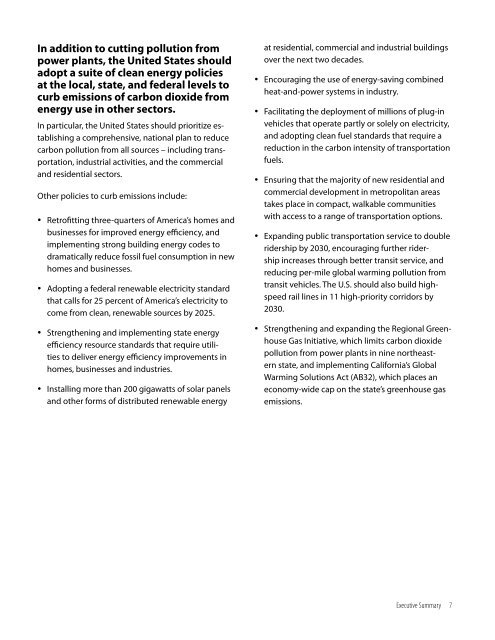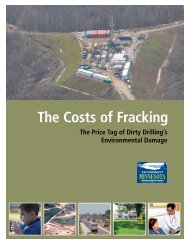America’s Dirtiest Power Plants
America's Dirtiest Power Plants - Environment Minnesota
America's Dirtiest Power Plants - Environment Minnesota
- No tags were found...
Create successful ePaper yourself
Turn your PDF publications into a flip-book with our unique Google optimized e-Paper software.
In addition to cutting pollution from<br />
power plants, the United States should<br />
adopt a suite of clean energy policies<br />
at the local, state, and federal levels to<br />
curb emissions of carbon dioxide from<br />
energy use in other sectors.<br />
In particular, the United States should prioritize establishing<br />
a comprehensive, national plan to reduce<br />
carbon pollution from all sources – including transportation,<br />
industrial activities, and the commercial<br />
and residential sectors.<br />
Other policies to curb emissions include:<br />
Retrofitting three-quarters of <strong>America’s</strong> homes and<br />
businesses for improved energy efficiency, and<br />
implementing strong building energy codes to<br />
dramatically reduce fossil fuel consumption in new<br />
homes and businesses.<br />
Adopting a federal renewable electricity standard<br />
that calls for 25 percent of <strong>America’s</strong> electricity to<br />
come from clean, renewable sources by 2025.<br />
Strengthening and implementing state energy<br />
efficiency resource standards that require utilities<br />
to deliver energy efficiency improvements in<br />
homes, businesses and industries.<br />
Installing more than 200 gigawatts of solar panels<br />
and other forms of distributed renewable energy<br />
at residential, commercial and industrial buildings<br />
over the next two decades.<br />
Encouraging the use of energy-saving combined<br />
heat-and-power systems in industry.<br />
Facilitating the deployment of millions of plug-in<br />
vehicles that operate partly or solely on electricity,<br />
and adopting clean fuel standards that require a<br />
reduction in the carbon intensity of transportation<br />
fuels.<br />
Ensuring that the majority of new residential and<br />
commercial development in metropolitan areas<br />
takes place in compact, walkable communities<br />
with access to a range of transportation options.<br />
Expanding public transportation service to double<br />
ridership by 2030, encouraging further ridership<br />
increases through better transit service, and<br />
reducing per-mile global warming pollution from<br />
transit vehicles. The U.S. should also build highspeed<br />
rail lines in 11 high-priority corridors by<br />
2030.<br />
Strengthening and expanding the Regional Greenhouse<br />
Gas Initiative, which limits carbon dioxide<br />
pollution from power plants in nine northeastern<br />
state, and implementing California’s Global<br />
Warming Solutions Act (AB32), which places an<br />
economy-wide cap on the state’s greenhouse gas<br />
emissions.<br />
Executive Summary 7



